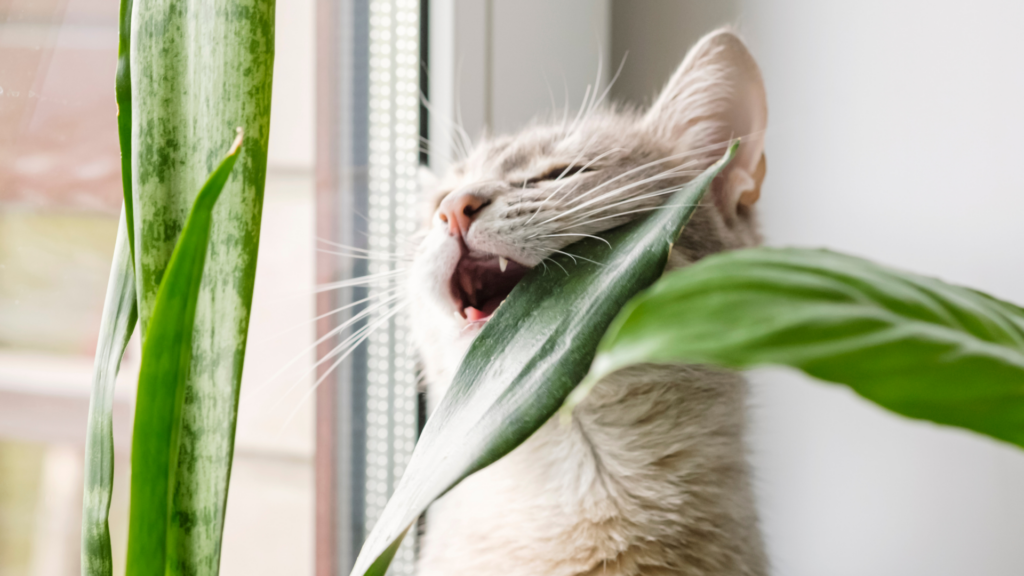Houseplants are more than just a decorative asset to brighten up your home – they’re powerful partners in purifying the air and removing toxins. However, not all houseplants are created equal, and some can be extremely toxic to your pets.
So how can you be sure your indoor plants won’t cause harm to your furry housemates? Read on for six toxic house plants to keep your four-legged friends away from, and six pet-approved plants to opt for in your home.
Contents
Poisonous for Pets
Aloe Vera Plants
The juice and gel found inside an aloe plant’s leaves are completely safe for pets, and can even be used as a topical treatment to soothe bee stings, burns, and other cuts and injuries. However, chewing on the plant’s outer leaves can expose a dog to toxins called anthraquinone glycosides, which can cause diarrhea and vomiting.
Peace Lilies
Known for their low-maintenance and ability to grow in low light, this common house plant (and all varieties of lilies) can bring everything but peace to your pets. If ingested, pets can experience vomiting, drooling and a loss of appetite.
Pothos + Philodendrons
Although these close relatives are two of the most common household plants, philodendrons and pothos plants are both poisonous to pets (and humans!).
And, like ivy, these plants are known to have a trailing habit, so they can easily droop down and grow to areas within your pets reach. Either keep these plants secured up high, or avoid them all together to prevent vomiting and diarrhea.
Snake Plants
Sansevieria, or snake plants, are fantastic for filtering out toxins in the air, but, ironically, they can also be toxic to pets, causing nausea, vomiting, and diarrhea if ingested. If you choose to keep a snake plant around for air filtration, just be sure to elevate it in a plant stand that’s out-of-reach for your pets.
Tulips
While the flower itself isn’t toxic, tulip bulbs contain toxins that can lead to gastrointestinal irritation, drooling, loss of appetite, convulsions, and cardiac abnormalities in pets if ingested.
ZZ Plants
ZZ plants have earned a reputation for being “tough as nails,” since they’re able to survive just about anywhere, even in extremely low light. So while they’re a top-choice for plant-parents, pet-parents should be wary before bringing a ZZ plant into the home.
Thankfully, ZZ plants don’t lead to death, but ingesting them can cause irritation or even burns for pets, so it’s best to either keep these plants out of reach for cats and dogs, or just keep them out of your home altogether.
Pet-Friendly
Bamboo Plants
Phyllostachys aurea – or golden or fishpole bamboo – is non-toxic to humans and animals. And, while chewing on it isn’t desirable, it won’t sicken your pet. In fact, bamboo’s foliage can contain up to 22% protein, so it could even be good for them!
Boston Ferns
Boston ferns are a houseplant favorite amongst pet owners since their shaggy fronds are non-toxic to cats and dogs, so all pet owners can feel confident about keeping one of these lush plants in the home.
Calatheas
Also referred to as “prayer plants” for the unique, daily movements their leaves make in response to light, members of the calathea family – like calathea, rattlesnake, pinstripe calathea, and the peacock plant – offer a pet-friendly pop of color to your home.
Date Palms
Unlike sago palms, which, when ingested, can cause extremely serious side effects like vomiting, diarrhea, seizures, and liver failure, date palms are a completely safe alternative for pets, and bring a modern, tropical vibe to the home.
Orchids
While they may be a bit cumbersome to care for, orchids are non-toxic to pets, making them that much more appealing for pet owners looking to bring a bit more beauty into their homes.
Spider Plants
A favorite among veterinarians, spider plants are easy to grow and great air purifiers. They’re also non-toxic, so you don’t need to worry about curious pets accidentally getting into their pots.
It’s important to remember that, even if a plant is pet-friendly, some insecticides used to keep them pest-free may still be toxic. Be sure to check the ingredients on all fertilizers and pesticides used in your indoor garden, and, for a complete guide of every plant and its potential pet toxins, visit the ASPCA’s list of Toxic and Non-Toxic plants.
If your dog is showing signs of ingesting a toxic plant, including drooling, rubbing of the mouth, vomiting, or diarrhea, contact your vet or the Pet Poison Hotline ASAP.



Just to be on the safe side, I only keep fake plants inside our home.